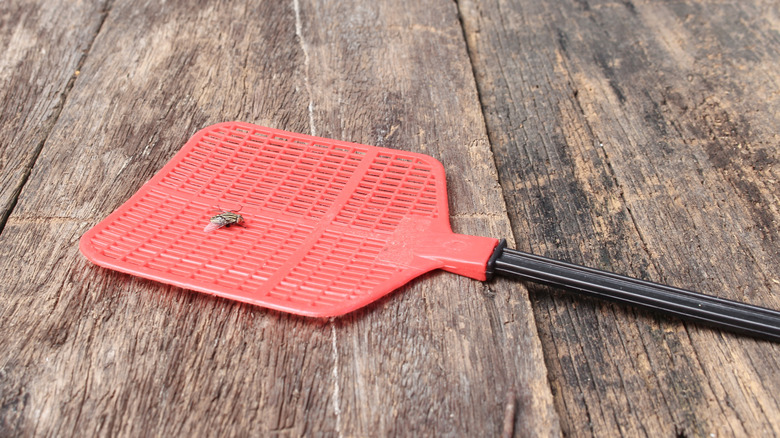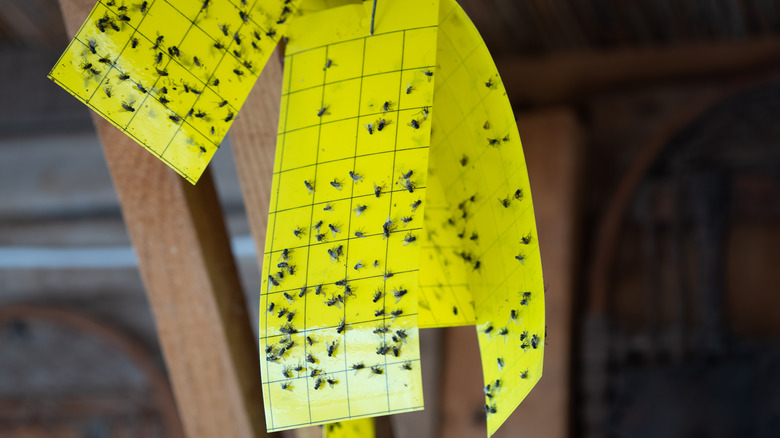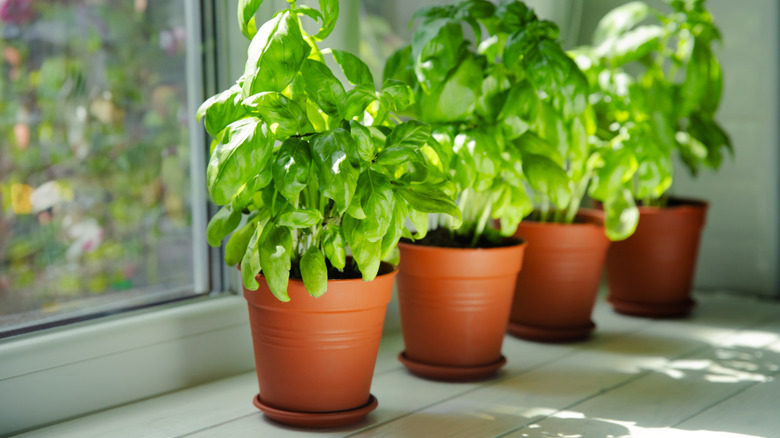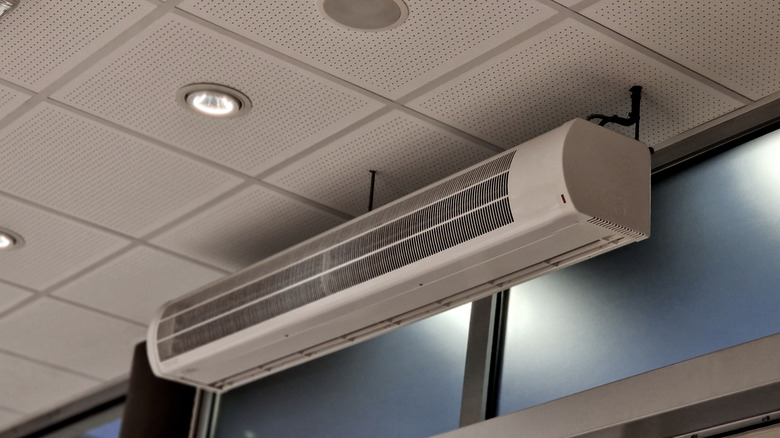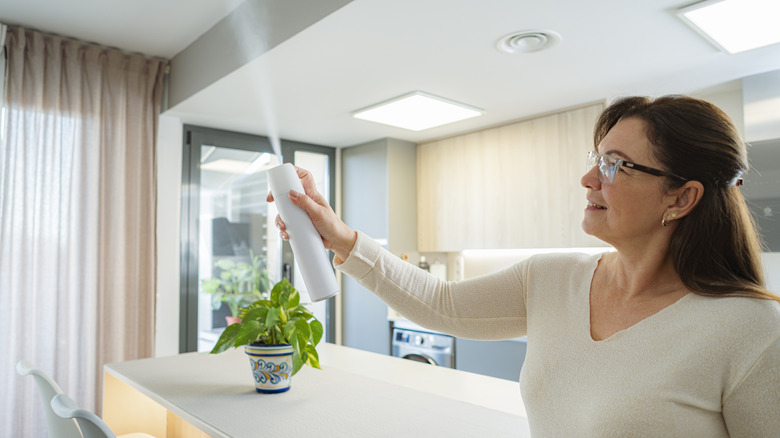12 Ways To Deter Or Eliminate Annoying Flies From The House
We may receive a commission on purchases made from links.
Many common flying insects can plague your home and disrupt your peace. They're annoying and disruptive to food preparation, dining, and other daily activities. Among the most common in and around residences are such species as house flies, bottle flies, and fruit flies. When allowed to exist and reproduce, house flies in particular can leave disgusting maggots and unsanitary residues on surfaces throughout your home, particularly in the kitchen, dining room, windows, and other areas where they congregate.
Many types of flies also present a risk to the health of household members. Houseflies can carry over 130 different pathogens, from bacteria to viruses, many of which can cause diseases in both humans and their beloved pets. Staphylococcus, streptococcus, and listeria (to name just a few) can all travel into your home on a fly's body. Fortunately, today we have more options than ever to eliminate pesky and potentially dangerous flies from our homes. Depending on the type of fly and size of the infestation, one of the following methods may help you reclaim your space from those annoying, disease-causing insects.
Fly swatters eliminate individual flies on surfaces
For many, nothing beats the effectiveness and sheer satisfaction of successfully using a fly swatter. However, they do require good aim and physical effort, which must be repeated for every fly. It's not a particularly efficient method, as you can usually only get rid of one fly at a time. Moreover, they leave a bit of mess that you'll need to clean, as well as the potential for an infected surface, both on the swatter and the area where the fly was killed.
To use a swatter successfully, wait for the fly to settle, then smack it quickly before disrupting it. To reduce the risk of disease or contamination, first use a paper towel to remove the fly's carcass. Then, clean both swatter and affected surfaces with a household disinfectant spray or wipe, such as Clorox Disinfecting Wipes. Make sure you choose a cleansing agent that will not harm the affected surfaces.
Sticky flypaper catches and immobilizes flying insects
Hanging a sticky flypaper strip near a window, door, or food prep area is an effortless way to capture flying insects before they begin to circulate in your home. Sticky fly paper is a strip of special paper covered with a strong adhesive. Some brands are also treated with a scent that is particularly attractive to flies. Other brands, such as Bugbane's Indoor Fly Strips, are odor-free.
Sticky paper is visually unappealing but highly effective. It also requires very little human effort, making it particularly useful for busy people. These traps are most effective when you hang them so that they're placed inside the flies' general flight zone, approximately five to six feet above the ground. Flypaper adhesive can be difficult to remove, so exercise caution in handling and replacing it. Due to the generally unappealing visual impact, more discreet methods may be preferred, especially in highly visible spots.
Install screens for windows and doors, then keep them in good repair
Keeping a home cool and well-ventilated often depends on screens for doors and windows. These can also keep your home fly-free while still allowing fresh air to circulate. For the best results in keeping flies out, look for mesh screens that feature 14 to 16 wires per square inch. Periodically remove your window screens to clean them with warm water, gentle dish soap, and a soft brush. You can also use white vinegar or baking soda, but avoid using bleach or other harsh chemical cleaners. Then, rinse them with clear water and reinstall the screens when dry. Just use a light touch to avoid bending the frames.
Small holes in your screens can allow flies to gain entry, defeating the purpose. So keep quick fixes, like Secopad's 14-Sheet Screen Repair Kit, on hand to easily patch any openings. However, if your screens have larger holes or major damage, you can repair them in a few steps. First, remove the damaged screen mesh, then stretch out a new length of screen mesh to replace it. Cut it carefully to size with scissors, leaving about a 1/2 inch overhang. Insert the screen mesh by either stapling or nailing with wire brads. Try not to stretch the screen too tightly. It should be taut, but not so tight that it pulls or splits. You can also purchase a repair kit, such as the King & Charles Window/Screen Door Replacement Kit, to ensure you have the materials you need.
Yellow outdoor lights keep many kinds of flies at bay
Using typical white light bulbs in outdoor fixtures tends to attract some fly species. So, swap out cool, bright outdoor lights with warmer yellow bulbs to help encourage flies to move along. Yellow lights may not actively repel flies, but they attract fewer insects overall.
Keep in mind, not every flying insect responds to the same wavelengths of light. So, whether you choose yellow-hued light bulbs or floodlights with a yellow lens, the switch may not keep all bugs away from your home. However, yellow-hued outdoor lights might provide an extra boost in keeping away some of the annoying flies you're trying to repel. Fortunately, this is also a budget-friendly solution. You can just switch your current bulbs with other energy-efficient and low-cost alternatives like Qualilux's Dusk to Dawn LED Bug Lights.
Apple cider vinegar traps attract fruit flies and drown them
Fruit flies are particularly common pests that can show up in many areas. They're particularly attracted to the scent of ripening and fermenting fruit. There are many methods, like using cinnamon, that may keep fruit flies out of your kitchen. Additionally, orange juice may also be effective at banishing fruit flies. However, apple cider vinegar has a strong scent that attracts them, making it an effective way to get rid of them.
Homemade DIY apple cider vinegar traps are easy to build and change out. They're also highly effective at getting rid of fruit flies. To make your own, add a cup of apple cider vinegar and a drop or two of liquid dish detergent to a small, shallow bowl. Cover the bowl tightly with cling wrap, then secure the wrap with a rubber band or string. Finally, poke several tiny holes in the cling wrap with a toothpick. Flies will be attracted to the solution's appealing scent and make their way into the bowl by way of those tiny holes without being able to get back out. The flies will then get trapped in the dish soap and drown in the vinegar.
Light traps attract and kill flies
Many types of flies are also attracted to certain kinds of light. Some traps that use light to draw in flies and lead them to their doom can take a few different forms. But in each case, it's not the light itself that's fatal to the fly. It simply draws them closer until some additional mechanism or substance does the dirty work.
Traditional models are typically used outdoors and use light rays to attract flies into the body of the trap, where they are fatally shocked. You'll want to use a model with a floor or tray underneath the light source and electrocuting mechanism. The tray catches the dead flies, so you will not have to continually sweep them up off your deck or patio. Simply remove the tray and empty it, then clean and reattach it. There are also non-shocking light traps, such as the Zevo Flying Insect Trap, that use blue light and UV light to attract flies to a sticky board that they can't escape from. These are more indoor-friendly, and the board is easily removable from the trap, so you can replace it with a new one.
The right essential oils can help repel and exterminate some flies
Research says that certain natural oils can have an impact on the presence and lifespan of some fly species. Most of the studied oils seem to repel them due to their strong scent. One popular example is eucalyptus oil. Sage is an aromatic, herb-based oil that can help naturally fight off flies. Other strong scents that can be effective include citronella and lavender, which is a calming scent that can also keep flies away.
One way to use natural oils easily is by creating a solution with some white vinegar and water. Put the solution into a spray bottle, then spray the solution on flies or on surfaces where they tend to congregate. Another option is to soak cotton balls in the same mixture of oil, vinegar, and water, then leave them in smaller, more contained spaces such as kitchen cabinets, trash bins, and pantries. You'll want to have a small saucer or ramekin to place the cotton ball in to avoid damaging your home's surfaces.
Basil can help keep your home free of flies
Sometimes people would rather not use essential oils for a number of reasons. After all, they can be messy to work with, and there's always a chance they can come into contact with surfaces that might be damaged. Plus, the strong, concentrated smell can prove unpleasant to humans as well as pets, and for chemically sensitive people, it could potentially cause unpleasant symptoms.
However, you can also use a potted basil plant for the same purpose. The plant is safe for humans, cats, and dogs. So, place basil plants throughout your home as well as outside near doors and windows that may serve as entry points for flies without worries over toxicity. Rue is thought to repel flies in the same way, but it can pose a health risk to your pets.
Magnetic fly curtains let air circulate but keep flies at bay
Screens work well in windows and doors to keep flies from entering the home. However, if you don't have a screen door installed on an exterior door, you'll probably find it easier to install a magnetic fly curtain. These are doorway-sized mesh screens that contain small but strong magnets in the center seam. Once hung in the doorway or across an open window, they can help keep your home fly-free.
Magnetic fly curtains are readily available from several retail outlets and are relatively inexpensive, such as the Mdavo Magnetic Screen Door. You can also use them on doors and entryways inside your home, leading from one room to another. This will help provide an additional barrier to repel flies from sensitive areas like the kitchen or a nursery.
An air curtain creates an invisible barrier for many flies
Imagine a steady flow of air pushing down from the ceiling to the floor, right in front of your door or window, keeping flies and other unwanted flying insects from entering the house. That's what an air curtain can do. These electronic appliances are mounted over openings and emit a constant, directed stream of air that acts as a barrier to flies.
Air curtains are also effective. In fact, one USDA Agricultural Research Service study established that they can prevent up to 99% of flying insects from gaining entry into an airplane. While they're probably more commonly found in commercial establishments, there are also models available to purchase for residential use. For example, Awoco's Super Power Indoor Air Curtain comes in a variety of sizes to meet the needs of various homes.
Take aim at flies with a salt gun
One helpful tool in your fight against household flies is salt. A salt gun is one quirky (yet effective) way to eradicate flies. It's a tool that's shaped like a shotgun and lets you literally shoot flies with household salt grains. Because the salt pellets leave the insect body relatively intact, they don't leave a gory mess, the way fly swatters do. They're most useful at short range, about two to three feet, and while they're not fatal against all flying insects, they seem to work well against house flies and mosquitoes.
While there aren't reliable research studies on the efficacy of salt guns against flies, they seem to have attracted some loyal fans. Product reviews from users indicate the Bug-A-Salt 3.0 salt guns work quite well against flies, especially if you have excellent aim. But before you rush out and buy one, check your state and local laws to make sure they're legal where you live.
If all else fails, try commercial spray insecticides
Don't be afraid to turn to commercially available insecticides made for home use. While they're potentially toxic, they can be safe if you follow the manufacturer's guidelines and use recommended safety precautions. Choose a product that's made specifically for your particular bug problem, as not all sprays and fogs are effective against every kind of flying insect.
Ensure you're using a product that's appropriate for residential use that won't pose a danger to your loved ones or household pets. To ensure you've selected the right spray or fog, check for a keyword on the can. "Caution" indicates a slight degree of toxicity and is preferred, while "Warning" indicates moderate risk, and "Danger" signals a high degree of toxicity. A product that's marked "Caution" and labeled as effective for flying insects, such as Hot Shot Flying Insect Killer, is formulated for in-home use.

